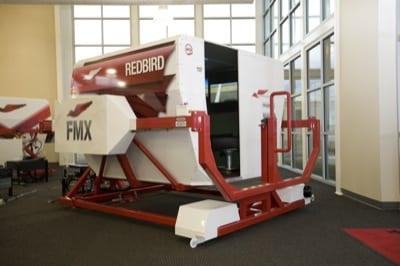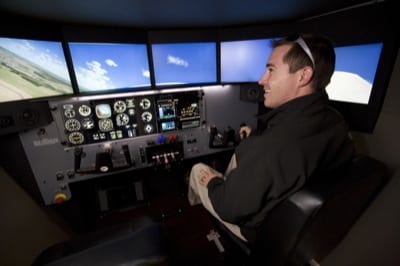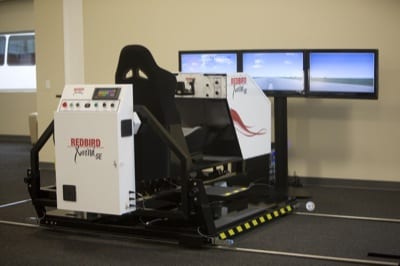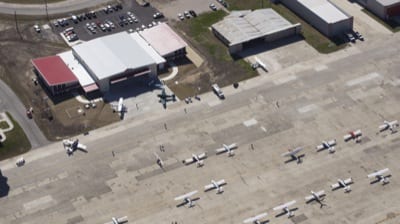Consider this: If you get a job flying for the airlines, you will have weeks, even months, of training in a simulator before you are allowed to touch an actual airplane. Does that give you an idea of the value of simulator training?
In October 2011 Redbird Skyport opened at San Marcos Municipal Airport (HYI) between Austin and San Antonio, Texas. Introduced with much fanfare at that year’s AirVenture, the Skyport has some GA heavyweights behind it, including Jerry Gregoire, chairman of Redbird Flight Simulations, John and Martha King of King Schools, and officials from the General Aviation Manufacturers Association, Aircraft Owners and Pilots Association, Cessna, Avemco, and other industry partners.
Its mission is to develop solutions to the challenges of a shrinking pilot population, a staggering student drop-out rate, and the ever-increasing cost of flight training. The aviation laboratory includes a full service FBO, flight school, and “aviation experience” center. All aspects of the project will provide a test bed for hardware, software, business processes and ideas with the goal of revitalizing general aviation. What’s even better: Everything learned at Skyport will be shared with the entire flight training community.
 A major component of Skyport is flight training with a curriculum built around the Redbird Flight Simulator. The school offers training for private pilot up through Airline Transport Pilot certification.
A major component of Skyport is flight training with a curriculum built around the Redbird Flight Simulator. The school offers training for private pilot up through Airline Transport Pilot certification.
“Everything is introduced and practiced in the sim before it is done in the aircraft. The basic idea is ‘Simulator for learning — airplane for demonstrating what you learned,'” explains Josh Harangue, marketing director.
 One of the challenges of having a flight simulator, even one as sophisticated as the full-motion FMX Redbird, is that some clients have the attitude “the simulator isn’t real, I’d rather fly the real thing,” even when the weather is not conducive to flight training. (Speaking as in instructor, when I encounter that attitude I create the current weather conditions in the Redbird and let the student get into “trouble” in the air. )
One of the challenges of having a flight simulator, even one as sophisticated as the full-motion FMX Redbird, is that some clients have the attitude “the simulator isn’t real, I’d rather fly the real thing,” even when the weather is not conducive to flight training. (Speaking as in instructor, when I encounter that attitude I create the current weather conditions in the Redbird and let the student get into “trouble” in the air. )
The dismissive attitude toward the simulator is not readily encountered at Skyport, says Harnagel.
 “Our website and marketing messages highlight the use of the simulators and most likely people who don’t understand the usefulness will choose somewhere else,” he notes.
“Our website and marketing messages highlight the use of the simulators and most likely people who don’t understand the usefulness will choose somewhere else,” he notes.
The use of the simulator during the intro flight is key, says Harnagel.
“The customer learns about the controls, instruments, and basic ‘feeling’ of flight before they get in the airplane,” he says. “Most immediately understand the benefit.”
In addition to the simulators, Redbird Skyport, which offers Part 141 training, has four 2012 Cessna 172s equipped with Garmin G1000 panels, and a 2012 Piper Seminole with a Garmin G500 panel.
According to Harnagel, about 40% of their students comes from the local area, another 50% come from outside the Austin-metro area and 10% come from overseas.
 Skyport has five full-time instructors, four part-time instructors and two check airmen. Dual instruction is done from 8 a.m. to 6 p.m. and the simulators are open for solo practice from 6 a.m. to 10 p.m.
Skyport has five full-time instructors, four part-time instructors and two check airmen. Dual instruction is done from 8 a.m. to 6 p.m. and the simulators are open for solo practice from 6 a.m. to 10 p.m.
Skyport officials also have struck a deal with Vaughn College in New York that offers college credits for flight training. “Additionally, many colleges will give credit for flight training,” he noted.
According to the Skyport website, the full-time course costs $9,995, which covers all simulator, airplane and instructor time, course study materials, written exam prep software and the written exam fee (provided the client takes the written exam at Skyport) and the practical test fee.
It also offers a part-time course, which is billed on an hourly basis. The cost ranges from $8,000 to $15,000, depending in the frequency and consistency of the training.
For more information: RedbirdSkyport.com

“Please find me a school that’s part 141, has modern Cessna G-1000 aircraft, full time professional instructors, aircraft that are properly maintained and the guarantee price for the private is $9995.”
That’s what the Skyport is. The $9995 doesn’t have a limit for time in the physical aircraft. You just have to prove proficiency for each maneuver in the sim before you get to try it in the real aircraft.
I am 51 yrs. old and as yet have not begun flight training. However, as mentioned in “Pats” reply, I can get certified for aprox. the same price. If it doesn’t reduce the price of training, I do not see the “draw” of simulation. If the price comes down over time ( as most tech. devices do ) I believe it could be a ” game-changer”.
The national average to get a PPL is approx. sixty hours, not forty, and from what I understand the students get unlimited practice time in the sim. It’s also been reported that most students at Skyport are finishing their PPLs with around 30 hours sim instruction and 30 hours in the aircraft. The Examiners have also stated that they perform extremely well on their check rides. As per the FAA, only 2.5 hours sim time in an AATD are allowed to be credited towards the 40 hours minimum flight time requirement for a PPL, however the FAA has given Redbird’s Skyport a waver that requires no set minimum in the aircraft. All of the aircraft at Skyport are brand new G1000 equipped C172s or Piper Seminoles, not clapped out 152s, and the facilities are first rate so if you think the price is steep, perhaps you should compare apples to apples. Skyport is a little different to one of those Florida shake and bake pilot training academies that churn out pilots using old 152s and based on the minimum requirements. If you want first rate training and service to produce the most proficient pilots, you need to pay for it. Flight training schools are after all, in business to make money, while satisfying the needs and requirements of their customers. I think Redbird is really moving in the right direction with these sort of ideas.
I can go anywhere and get a private certificate for $9995. That includes all flight instruction an an airplane burning gas. It’s crazy to charge me the same price for being taught in a simulator and demonstrating skills in an aircraft. Are they saying you get 40 hours of flight time for that price? If they’re substituting any flight time for simulator time, I want a lower price. I wonder what the “wet” price per hour is for a simulator!
Wet price is the cost of electricity or depending on where you live about $2.50 an hour.
Pat:
Please find me a school that’s part 141, has modern Cessna G-1000 aircraft, full time professional instructors, aircraft that are properly maintained and the guarantee price for the private is $9995.
Respectfully,
Vinny
IMHO, the Question isn’t just cost. The other question is, even with cost being equal, are they retaining more students? Are they converting a larger percentage of students into pilots? Do these students feel more “successful” as they progress in general? And are these new pilots or “incremental” pilots to the population stronger/safer/better prepared for adversity than regular gas-driven pilots because they’ve been exposed to more time and more types of adversity more thoroughly?